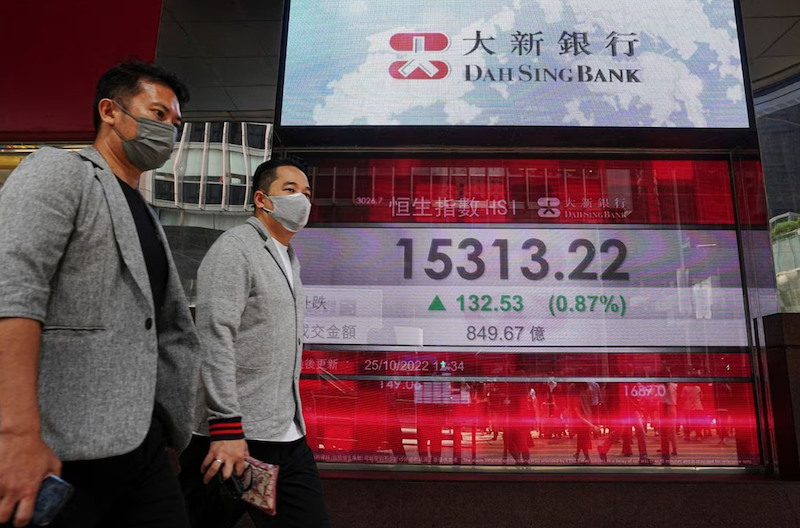Chinese stocks made a sharp rebound from half-a-decade lows this week, on the back of wide-ranging measures from Beijing, even as inflation data pointed to a deepening crisis in the economy.
China’s blue-chip CSI 300 Index saw its best week since November 2022, with gains of 5.8%, as it closed on Thursday at 3,364.93 points.
The country’s markets will now be closed for a week beginning Friday for the Lunar New Year holiday.
Also on AF: Investors Exiting China Flock to India Despite Overheating Risk
The week brought some much needed respite for Chinese investors after markets slumped to five-year lows last Friday.
Recovery bets came on the back of buying by state-linked entities, multiple moves by Chinese regulators to curb short-selling and reports that President Xi Jinping would meet regulators earlier this week.
China’s cabinet on Wednesday also sacked the markets regulator’s chief Yi Huiman. Wu Qing, a veteran securities regulator, will now take the reins at the China Securities Regulatory Commission. Wu has led the Shanghai Stock Exchange and is known for his tough line on market malpractice.
“It seems that Beijing has noticed the sharply falling stock market,” portfolio manager Rob Brewis, at UK-based Aubrey Capital Management, said.
“Hard to say how effective the new man is until we see some policies… (It) won’t impact the economy or property market, which seems to be the major problem, but might well instigate a bounce in the stock market.”
Economy downcast
How long China’s market recovery will sustain remains to be seen, considering broader economic data out of the world’s second-largest economy continued to disappoint.
Figures released on Thursday showed China’s consumer prices fell at their steepest pace in more than 14 years in January. Producer prices also dropped, pointing to the country’s fragile post-Covid revival.
“The government remains, in our view, behind the curve in dealing with deflationary pressure,” said Aninda Mitra, head of Asia macro and investment strategy at BNY Mellon Investment Management.
“We think the policy mix needs to shift more decisively to bigger fiscal easing in support of households and consumers, with the (People’s Bank of China) playing a complementary role in keeping borrowing costs low.
“In the absence of such measures, risks are growing of a Japanification of China’s long-term macro outlook.”
View this post on Instagram
Markets to remain challenging
The inflation data underscores the challenge before regulators in stabilising China’s rocky markets.
A raft of measures – such as suspending brokerages from borrowing shares for lending, curbing margin-lending and other derivatives, and even getting exchanges to halt selling by hedge funds – have barely helped.
State fund Central Huijin Investment has also stepped up investment in stock exchange-traded funds (ETFs).
Yet, as the S&P 500 closes in on the magic 5,000 level, Chinese blue chips in January clocked six straight months of losses.
The CSI 300 Index is still down 2% for the year — despite this week’s rally — highlighting the rush of money fleeing China’s crumbling stock markets.
The Shanghai Composite Index also jumped 1.3% on Thursday and was up 5% for the week. But it remains more than 3.5% lower year-to-date.
The country’s central bank has also been busy trying to defend the yuan amid the stock market rout.
The PBOC on Thursday set the midpoint rate around which it allows the yuan to trade – in a 2% band – at 7.1063 per US dollar, 848 pips firmer than market estimates.
The onshore yuan last stood at 7.1954 a dollar, little changed following the release of inflation figures.
Its offshore counterpart rose roughly 0.1% to 7.2073 per dollar.
- Reuters, with additional editing by Vishakha Saxena
Also read:
China Appoints New Securities Regulator as Markets Flounder
Critics Say China’s ‘National Team’ Can’t Fix Its Sinking Markets
Chinese Investors Keen on Banned Crypto, as Stocks Lost Value
Investor Fever Sees Chinese US Stocks Fund Halt Trading
Losses on $50bn Leveraged Products Behind China Stocks Plunge
China Real Estate Funds Crash as Economic Gloom Persists
Brokers in China Seen Restricting Cross-Border Stock Trades
China Told Only Major Intervention Can Turn Economy Around
























